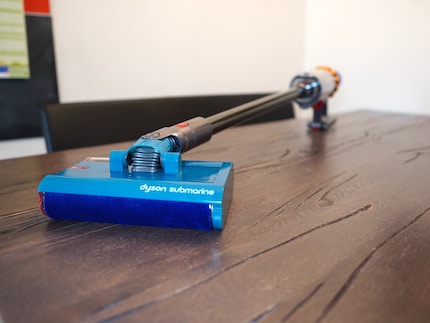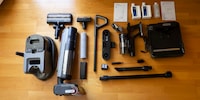

The imperfect replacement mop : the Dyson Submarine
The Submarine attachment for the Dyson V15 automatically mops up liquids off the floor. The test reveals: it cleans as well as Dyson promises. But there are also some surprising weaknesses.
Whether its thick soy sauce, cornflakes with milk, dried tomato sauce or sticky honey, the Dyson V15s Detect Submarine has to show what it’s really capable of in the test. Will this really be easier and more comfortable than with a mop?
To clarify, the Submarine is the first attachment for the Dyson cordless vacuum cleaner that mops up liquid. However, you can’t buy it separately, it only works with a special version of the V15 Detect. Say: if you want to mop with Dyson, you have to buy the vacuum which has the 2021 technology, which comes with a Submarine attachment.
CH

EU
Of course, the V15 is still a good vacuum cleaner with a lot of power and a nozzle with the green laser that lights up the dust particles on the floor. But in the meantime, a new model with even more suction power and an improved laser has come out, at a similar price at that. So the choice is yours: either you get the latest Dyson, or the older model and the Submarine.
Deep cleaning test with honey and dried sauce
Back to the mess on the floor. I fill the tank with water and attach the wet roller head. The suction function is now deactivated, the head section only supplies power to the roller and the water pump. This moistens the microfibre cover on the roller and the waste water is immediately collected in a separate container. More on that later.
First, I start cleaning: I press the button and the roller turns, which I feel from slight vibrations. In addition, the Dyson pulls forward slightly. When mopping up liquid, the Dyson is once again much quieter than when vacuuming. I can easily roll forward and backward across the floor. In the video below, you can see in detail how the Dyson copes with the four types of dirt in my test.
Soy sauce: This is a thick and slightly sticky sauce. Run the Submarine over it once and the sauce is almost all gone. However, some of it has simply spread further, but after four times back and forth it eventually wipes every last spec up. The floor also no longer smells like soy and isn’t sticky.
Cornflakes with milk: The new Dyson is also supposed to be able to pick up solid pieces. The milk has gone immediately, and the roller also shovels the cornflakes into the dirty water tank. But again, you redistribute some of the dirt each time you pull back. I’ll tell you why that happens later on.
Dried tomato sauce: Looks like something out of a horror movie, but it’s just red sauce. However, these dried stains are particularly stubborn. I go over it multiple times, but not everything gets removed. It’s only when I pour a bit of water onto the floor and additionally moisten the stains that I get rid of all the splashes.
Honey: Normally, cleaning the greasy mass would be a nightmare. The Submarine cleans it up pretty easily. The floor isn’t sticky after either.

Source: Lorenz Keller
Advantages and disadvantages to deep cleaning
The test and everyday use of the Dyson V15 Detect Submarine clearly shows that the wet roller head cleans up liquid messes well. The firmer, harder and drier stains and dirt are, the more trouble it has. Two problems arise from this: the amount of dirt and the waste tank.
The roller can only pick up a limited amount of dirt. If there’s a large amount on the ground, some of it’s simply smeared first. However, since the dirty water in the microfibre mesh is squeezed out into the waste tank each time and clean water flows in, it takes several passes if there’s a lot of dirt in one place for everything to get clean.
This is also due to the fact that the Submarine uses clean water in fairly measured doses. The advantage is that after you’ve cleaned, the floor isn’t wet (just damp). However, you can’t adjust the degree of moisture itself by spraying more water on the roller.

Source: Lorenz Keller
The waste tank can spill over
The Achilles heel of the Dyson is the container for the waste water and dirt. At 360 millilitres, it’s slightly larger than the 300-millilitre water tank. But if you clean up a lot of liquid, it fills up surprisingly quickly. There’s no warning to say the waste tank is full.
So you shouldn’t wait until the fresh water tank is empty, but rather empty the waste water earlier. After all, liquids slosh back and forth during the cleaning movement. The more liquid there is, the greater the risk of dirt getting back onto the roller. This is exactly what happened to the cornflakes, which then got stuck on top.

Source: Lorenz Keller
This backflow can also happen when you run to the sink with the Submarine attachment in hand to clean everything. That’s why you have to move carefully in case of larger amounts of liquid and dirt and empty the container regularly.
Still, the entire attachment can be disassembled easily, as is typical for Dyson, and you can rinse and clean everything well under the water, including the wet roller head with the microfibre cover. According to the manufacturer, you should replace it every six months to keep it hygenic.

Source: Lorenz Keller
The lowdown: it mops up liquid well, if you have a good technique
The Submarine passed the endurance test with some reservations. It cleans really well, but you need to know exactly how to handle the waste tank. Of course, you can also clean moderately dirty floors with the Submarine.
However, you should definitely vacuum beforehand – which you can do wonderfully with the other attachments of the Dyson. Otherwise, you’ll just have a roller smeared with a mush of wet dust. In principle, the same rules apply here as when you clean with a mop and bucket.

Source: Lorenz Keller
What about parquet flooring? Dyson says you can use the Submarine on all floors. However, various guidebooks explicitly warn against microfibre cloths. At the Swiss Parquet Association (page in German), the statements are more differentiated: there’s definitely suitable microfibre fabric that is approved by the manufacturers for wood floors. And that’s the case here. The big advantage here is that the Dyson doesn’t use a lot of water to clean and the moisture is also continuously released.
Overall, the Submarine is only worth it if you wanted to buy a new vacuum cleaner anyway. Because that’s what you’ll have to do to use the attachment. The Submarine is certainly more comfortable for washing your floor. But it’s not going to do all the manual labour for you either.
Header image: Lorenz Keller
Gadgets are my passion - whether you need them for the home office, for the household, for sport and pleasure or for the smart home. Or, of course, for the big hobby next to the family, namely fishing.




